
If you’ve read my books, or listened to the podcast/audio version, you might be asking, are pine fries really a thing? I didn’t make them up. They are a thing.
Actually, some Native American tribes were known for their eating of tree bark. The name Adirondack is an Iroquois exonym meaning “bark eaters.” Northern Scandinavians like the Sami and the Finns ate tree bark too. I don’t know how the Adirondack people ate their tree bark. The Sami and Finns dried theirs and ground it into a sort of coarse meal (not quite “flour”) which could be stored and cooked later.
In the Siege story, the Andy character introduces bark as a food, calling it “pine fries.” I’ve made pine fries several times, but not tried to make pine bark flour yet. I will put that on my list of things to try.
Silver Lining
The edible part isn’t the gray and corky outer bark. It’s the thin whiteish layer known as the cambium. This the living part of the tree. Beneath that thin white layer is the wood. Getting to that thin layer is the challenge.
How To Make Pine Fries
I’ve made pine fries several times, but never took any photos. For this blog post, I did a little sample AND remembered to take pictures. I selected a big white pine that I didn’t mind too much if it died. Taking out a football-shaped piece of bark generally doesn’t harm the tree much, but if the tree eventually died, I wouldn’t mind.
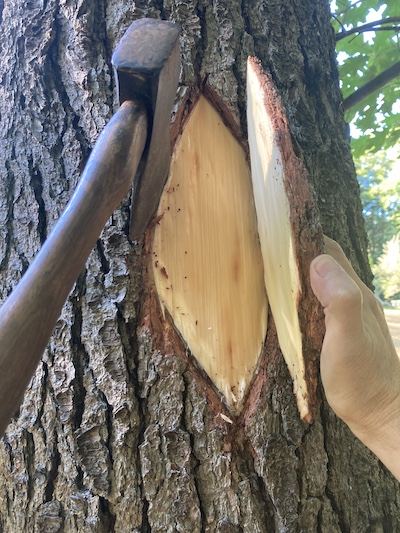
The outer bark is tough (by design) so it takes a bit of hatchet work or digging with a knife to get down to the cambium. Once you do cut deep enough, the bark will shift around a bit as it works loose. Pry it up with a sturdy knife, be sure that you’re prying up the soft white layer with it.
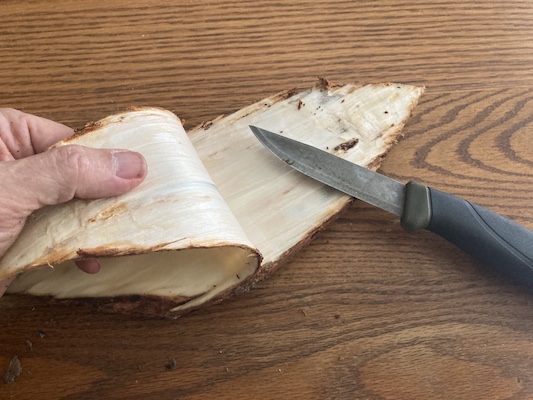
Use a knife to start the separation of the cambium from the tough outer bark. Once you’ve got enough to hold onto, you can pull the cambium away.
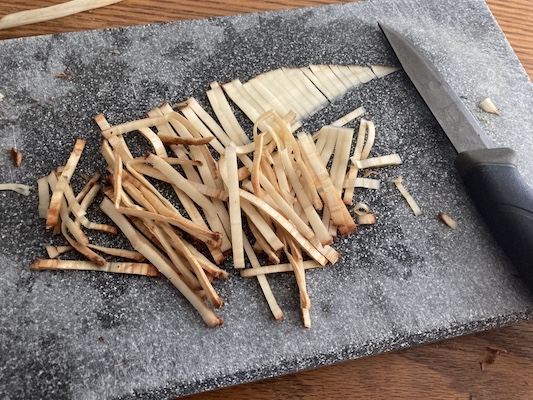
Cut across the grain. I do 1/8th-inch strips. This yields short fibers that will be easier to chew. Even in thin strips, pine bark is still kind of tough. Expect to chew.
Much like apples, the cambium will start to turn brown as it’s exposed to air.

Dry pan ‘frying’ essentially speeds up the drying process. Cambium is approximately 12% water. The thin strips brown rather quickly. It only takes a couple minutes over medium heat. When they get toasty brown, they’re done. Salt to taste.
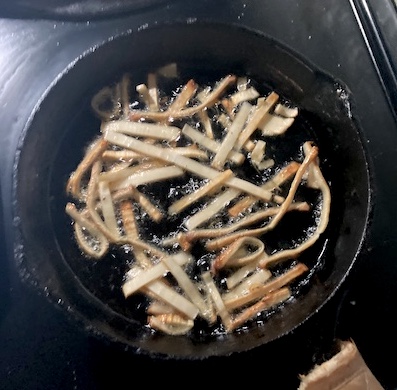
Frying in a bit of oil works better for distributing the heat. They cook just as quick, though. Salt or season to taste.
Taste?
I’ve read that dried pine bark tasted like pine sawdust. Having not eaten sawdust, I can’t confirm or deny. To me, pine fries don’t have much taste. Hence a dash of salt or other seasonings. Oil-fried pine fries get a bit of taste from whatever the oil is. The salt sticks better too.
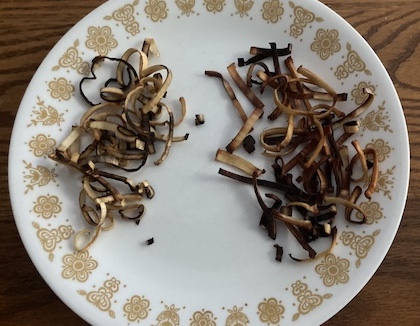
On the left are the dry-fried. On the right, fried in oil. Together, the two little piles were about an ounce of pine bark (pre-cooked weight)
Food Value?
Pine cambium has around 80 calories per 100 grams. That’s roughly 28 calories per ounce. Wheat, by contrast, has about 360 calories per 100 grams. That explains why our European and Middle-eastern ancestors cultivated wheat instead of just eating bark. Rice has around 120 calories per 100 grams.
My 12-inch by 5-inch football shape yielded about 1 ounce of cambium: 28 calories. I probably spent more calories than that cutting out the shape, to be honest. However, in a survival situation, you wouldn’t care if you killed the tree and would be taking far larger pieces. An economy of scale. In Chapter 15 of Book 3, the folks at the town farm are stripping an entire (felled) tree: a much better calorie return on calorie investment.
Pine bark isn’t some secret superfood. It does, however, have some calories in the form of carbs and can be stored (dried) for later. In a survival situation, even modest calories could be crucial. Fortunately, pine trees are fairly common.
